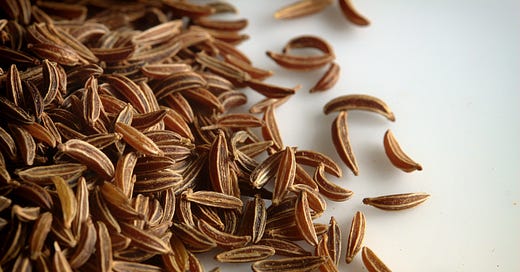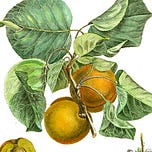A few weeks ago we looked at the history of the carrot, and I mentioned that the name may have originated in Greek κέρας (‘keras’ = horn), alluding to the tapered shape of the root. An alternative theory connects the carrot with κᾰρωτόν (karoton). It’s not entirely clear which plant this was, but the word may be related to an earlier Greek word καρώ (karō), meaning ‘caraway’.
Just a glance at their leaves is enough to show that carrot and caraway are indeed members of the same family, so it makes sense that their names might also be related. But what exactly is caraway?
Best known as a culinary spice, Carum carvi is not dissimilar from its close relative, cumin. However, caraway’s aromatic scent is more like aniseed or fennel. Originating in the Middle East, for many thousands of years it has been a staple of mid-European cuisine, where it is found in rye-bread, soups, pickles such as sauerkraut and even liqueurs.
Although the seeds are the most commonly consumed part of the caraway plant, the leaves are also used in traditional dishes such as Norwegian karvekålsuppe, a soup made of karve = caraway and kål = cabbage.
Karve (along with Dutch karwij and English caraway) is derived from carvi, the spice’s name in mediaeval Latin as well as in modern French. And they are all ultimately derived from καρώ (karō) via the Arabic كراويا (karawiya). But in Spanish, thanks in part to that country’s strong trading links with Arabia, the word has formed differently, attracting the Arabic definite article ‘al’ and becoming alcaravea.
What’s the difference?
Things become a little more complicated with the arrival of cumin in the linguistic spice-rack. Cuminum cyminum has its origins in Hebrew כמון (‘kammon’), and is recorded as ku-mi-no in Linear B tablets dating from 1500 BC. Ancient Greek κύμινον (kuminon) became Latin cuminum, from which come Albanian qimnon, Turkish kimyon and ultimately English cumin.
However, the similarity of the two plants and their seeds led to many languages adopting the same word to refer to both. In countries where the fennel-scented caraway was already the more traditional ingredient, cumin was identified by the addition of an epithet — often a place-name.
For instance, a number of central and east European countries call cumin ‘Roman cumin’, since it travelled north from the Mediterranean. This is the case with Polish kmin rzymski (‘Roman cumin’), as well as Norwegian, Latvian, Lithuanian, Czech and Hungarian.
Elsewhere, it is caraway that has to be distinguished. So in Italy, caraway is cumino tedesco (German cumin), and in Turkey, frenk kimyonu (Frankish cumin).
A complete outlier is the Slovak word rasca for caraway. It’s unclear where it comes from, although Ľubor Králik, author of the Slovak etymological dictionary, traces it to an ancient diminutive *rastca/*rostca, meaning ‘something red’ or ‘red plant’.1
Currying flavour
If caraway is the seed of choice in Europe, the hotter and spicier cumin is a major ingredient of Indian dishes. Ask your local Indian restaurateur what’s in your curry and they will tell you jeera, from the Hindi जीरा (jira) meaning ‘cumin’.
Ultimately derived from Sanskrit जीरक (jiraka), the same word comes via Persian into Kazakh and Russian as зира (zira).
The story of caraway and cumin is a typical one, in which an imported plant closely resembles an indigenous or more familiar variant. Many speakers will depend on local context to define which particular spice they want, and end up calling them all a variant of the same word: ‘cumin’, ‘kmin’ or ‘kim’. Others, as explained above, will seek to differentiate them, for example by applying placenames.2
But there is a third, fascinating, possibility: the development of a new word through phonological change, driven by a need to differentiate. This has evidently happened in Ukrainian and Russian, where ‘kmin’ has mutated into ‘tmin’. This later form is generally used to mean ‘caraway’, while the original ‘kmin’ is reserved, like ‘zira’, to refer to cumin.
Janyšková, I, and H. Karlíková (eds.). 2009. Studia Etymologica Brunensia 6. Praha: Nakladatelství Lidové noviny, p.120 https://sciendo.com/pdf/10.2478/v10122-010-0019-5
For a complete list of the fascinating variants of the names of both plants, see Ravindran, P. 2017. The Encyclopedia of Herbs and Spices, available at this link













Share this post